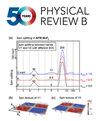远距离相互作用的哈伯德模型筛选
IF 3.7
2区 物理与天体物理
Q1 Physics and Astronomy
引用次数: 0
摘要
我们为长期以来的假设提供了确凿的证据,即具有短程相互作用的模型哈密顿量忠实地再现了实际材料中远程库仑相互作用的物理特性。为此,我们提出了一个通用的Hubbard模型,该模型在没有费米表面嵌套的情况下捕获了金属、莫特绝缘体和电荷密度波(CDW)绝缘体之间的量子相变。通过比较半填充链上具有最近邻相互作用和1/r-远程相互作用的1/r-Hubbard模型的量子相图,我们认为包含远程相互作用对于正确描述相互作用的多电子系统不是至关重要的。为此,我们采用有限晶格和反周期边界条件下的密度矩阵重正化群方法,确定了金属Luttinger液体弱相互作用、Mott-Hubbard绝缘子优势场相互作用和CDW绝缘子优势场相互作用之间的量子相变。这两种相图在性质上是一致的,因为在这两种情况下量子相变都是连续的。此外,简单的Hartree-Fock理论和原子极限提供了重整化因子,使我们能够定量地将两个相图映射到彼此上。作为一个实际的优势,我们的研究结果表明,通过使用仅具有短程相互作用的模型,计算工作量可以大大减少。2025年由美国物理学会出版本文章由计算机程序翻译,如有差异,请以英文原文为准。
Screening in Hubbard models with long-range interactions
We provide solid evidence for the long-standing presumption that model Hamiltonians with short-range interactions faithfully reproduce the physics of the long-range Coulomb interaction in real materials. For this aim, we address a generic Hubbard model that captures the quantum phase transitions between metal, Mott insulator, and charge-density-wave (CDW) insulator, in the absence of Fermi-surface nesting. By comparing the quantum phase diagrams for the 1/r-Hubbard model on a half-filled chain with nearest-neighbor and 1 / r Published by the American Physical Society 2025
求助全文
通过发布文献求助,成功后即可免费获取论文全文。
去求助
来源期刊

Physical Review B
物理-物理:凝聚态物理
CiteScore
6.70
自引率
32.40%
发文量
0
审稿时长
3.0 months
期刊介绍:
Physical Review B (PRB) is the world’s largest dedicated physics journal, publishing approximately 100 new, high-quality papers each week. The most highly cited journal in condensed matter physics, PRB provides outstanding depth and breadth of coverage, combined with unrivaled context and background for ongoing research by scientists worldwide.
PRB covers the full range of condensed matter, materials physics, and related subfields, including:
-Structure and phase transitions
-Ferroelectrics and multiferroics
-Disordered systems and alloys
-Magnetism
-Superconductivity
-Electronic structure, photonics, and metamaterials
-Semiconductors and mesoscopic systems
-Surfaces, nanoscience, and two-dimensional materials
-Topological states of matter
 求助内容:
求助内容: 应助结果提醒方式:
应助结果提醒方式:


